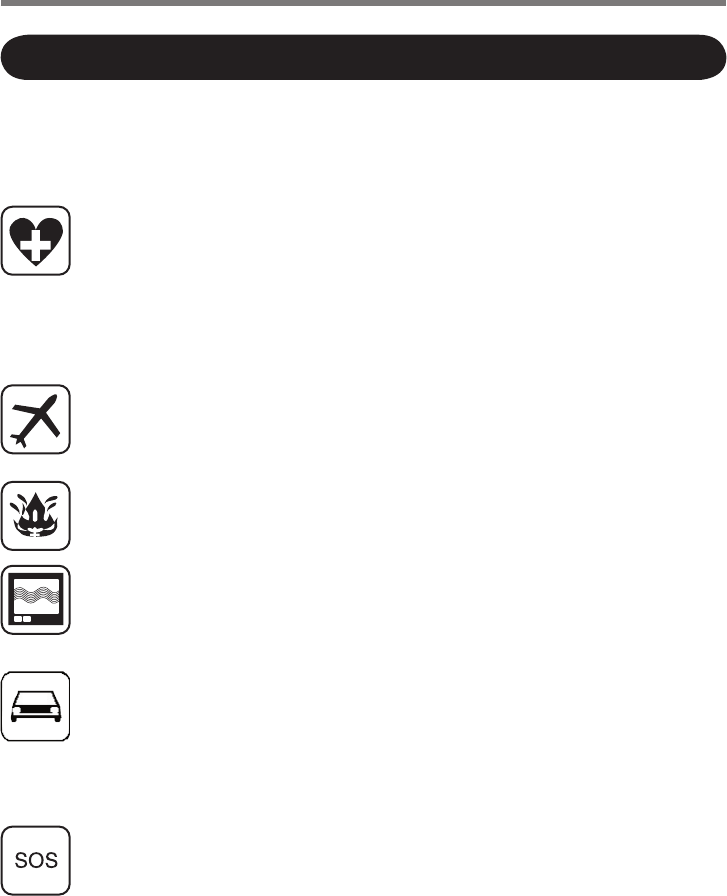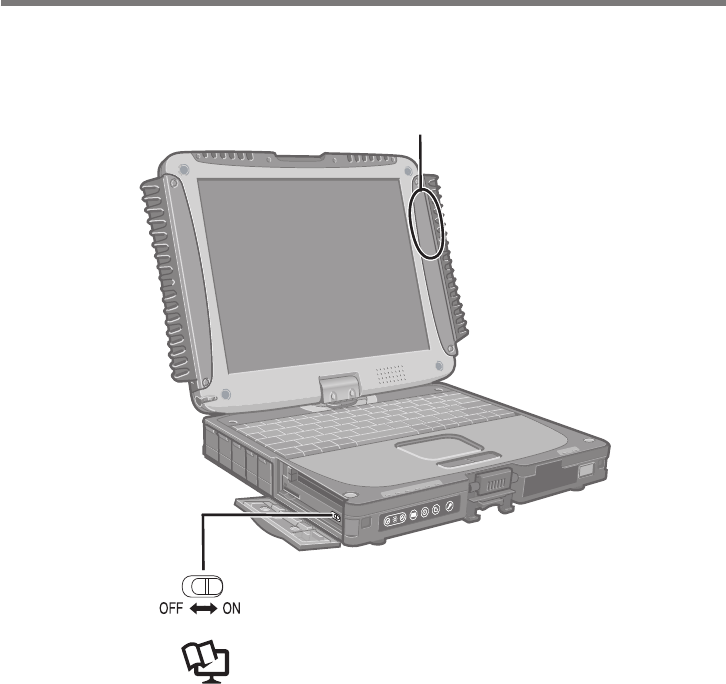Panasonic of North America 9TGCF-197 Portable PC Model CF-19 Family User Manual sample CF19 HSDPA indd
Panasonic Corporation of North America Portable PC Model CF-19 Family sample CF19 HSDPA indd
Contents
- 1. USER MANUAL CF 19
- 2. USER MANUAL HSDPA
USER MANUAL HSDPA

1
Contents
Precautions ...............................................................................2
Names and Functions of Parts .................................................4
Supplementary Instructions
for HSDPA/UTMS Modem
Model No. CF-19 Series
Personal Computer

2
The following safety precautions must be observed during all phases of the operation, usage, service
or repair of any Personal Computer or Handheld Computer incorporating WWAN. Manufacturers of the
cellular terminal are advised to convey the following safety information to users and operating person-
nel and to incorporate these guidelines into all manuals supplied with the product. Failure to comply
with these precautions violates safety standards of design, manufacture and intended use of the prod-
uct. Panasonic assumes no liability for customer failure to comply with these precautions.
When in a hospital or other health care facility, observe the restrictions on the use of mobiles.
Switch Personal Computer or Handheld Computer incorporating WWAN off, if instructed to do so
by the guidelines posted in sensitive areas. Medical equipment may be sensitive to RF energy.
The operation of cardiac pacemakers, other implanted medical equipment and hearing
aids can be affected by interference from Personal Computer or Handheld Computer in-
corporating WWAN placed close to the device. If in doubt about potential danger, contact
the physician or the manufacturer of the device to verify that the equipment is properly
shielded. Pacemaker patients are advised to keep their Personal Computer or Handheld
Computer incorporating WWAN away from the pacemaker, while it is on.
Switch off Personal Computer or Handheld Computer incorporating WWAN before board-
ing an aircraft. Make sure it cannot be switched on inadvertently. The operation of wireless
appliances in an aircraft is forbidden to prevent interference with communications systems.
Failure to observe these instructions may lead to the suspension or denial of cellular ser-
vices to the offender, legal action, or both.
Do not operate Personal Computer or Handheld Computer incorporating WWAN in the presence
of fl ammable gases or fumes. Switch off the cellular terminal when you are near petrol stations,
fuel depots, chemical plants or where blasting operations are in progress. Operation of any elec-
trical equipment in potentially explosive atmospheres can constitute a safety hazard.
Your Personal Computer or Handheld Computer incorporating WWAN receives and trans-
mits radio frequency energy while switched on. Remember that interference can occur if it
is used close to TV sets, radios, computers or inadequately shielded equipment. Follow any
special regulations and always switch off Personal Computer or Handheld Computer incor-
porating WWAN wherever forbidden, or when you suspect that it may cause interference or
danger.
Road safety comes fi rst! Do not use a Personal Computer or Handheld Computer incorporating
WWAN while driving a vehicle. Do not place the computer with WWAN in an area where it could
cause personal injury to the driver or passengers. It is recommended to stow the unit in the boot
or secure stowage area while driving.
Do not place the computer with WWAN in an area over an air bag or in the vicinity where an air
bag may deploy.
Air bags infl ate with great force and if the computer with WWAN is placed in the air bag deploy-
ment area may be propelled with great force and cause serious injury to occupants of the vehicle.
IMPORTANT!
Personal Computer or Handheld Computer incorporating WWAN operate using radio sig-
nals and cellular networks cannot be guaranteed to connect in all conditions. Therefore,
you should never rely solely upon any wireless device for essential communications, for
example emergency calls.
Remember, in order to make or receive calls, Personal Computer or Handheld Computer in-
corporating WWAN must be switched on and in a service area with adequate cellular signal
strength.
Some networks do not allow for emergency calls if certain network services or
phone features are in use (e.g. lock functions, fi xed dialing etc.). You may need to deacti-
vate those features before you can make an emergency call.
Safety Precautions
Precautions

3
Some networks require that a valid SIM card be properly inserted in Personal Computer or
Handheld Computer incorporating WWAN. 27-E-1-1
Federal Communications Commission
Radio Frequency Interference
Statement
Note: This equipment has been tested and found
to comply with the limits for a Class B digital de-
vice, pursuant to Part 15 of the FCC Rules. These
limits are designed to provide reasonable protec-
tion against harmful interference in a residential
installation. This equipment generates, uses and
can radiate radio frequency energy and, if not
installed and used in accordance with the instruc-
tions, may cause harmful interference to radio
communications. However, there is no guarantee
that interference will not occur in a particular in-
stallation. If this equipment does cause harmful
interference to radio or television reception, which
can be determined by turning the equipment off
and on, the user is encouraged to try to correct
the interference by one or more of the following
measures:
Reorient or relocate the receiving antenna.
Increase the separation between the equip-
ment and receiver.
Connect the equipment into an outlet on a cir-
cuit different from that to which the receiver is
connected.
Consult the Panasonic Service Center or an
experienced radio/TV technician for help.
Warning
To assure continued compliance, use only
shielded interface cables when connecting to
a computer or peripheral. Also, any changes or
modifications not expressly approved by the party
responsible for compliance could void the user’s
authority to operate this equipment.
FCC RF Exposure Warning:
This equipment is provided with PC Card slot
that could be used with wireless transmitters,
which will be specifically recommended when
they become available.
For U.S.A.
been RF exposure evaluated for use with this
computer and may not comply with FCC RF
exposure requirements.
This equipment complies with FCC radiation
exposure limits set forth for an uncontrolled
environment.
This equipment has been approved for por-
table operation, and if provided with WWAN
transmitter, requires LCD side panel spacers
to provide minimum 1.5 cm spacing between
antenna located within the LCD side panel,
and all person’s body (excluding extremities of
hands, wrist and feet) during wireless modes
of operation.
This equipment may use multiple installed
transmitters, which may be capable of simulta-
neous transmission.
This equipment is provided with external anten-
na connector(s) for connection to optional Car
Mounter or Port Replicator for mobile external
mounted antenna(s). External antenna(s) must
be professionally installed and cannot exceed
recommended maximum antenna gain as
described in individual provided supplement
instructions for wireless transmitters. Also,
user must maintain minimum 20 cm spacing
between external antenna(s) and all person’
s body (excluding extremities of hands, wrist
and feet) during wireless modes of operation.
25-M-1-1
This device complies with Part 15 of the FCC
Rules. Operation is subject to the following two
conditions:
(1) This device may not cause harmful interfer-
ence, and
(2) This device must accept any interference re-
ceived, including interference that may cause
undesired operation.
Responsible Party:
Panasonic Corporation of North Ameri-
ca

4
(Appearance may differ depending on specifications.)
Names and Functions of Parts
Wireless Switch
⇒ Reference Manual “Wireless Switch Utility”
© 2007 Matsushita Electric Industrial Co., Ltd. All Rights Reserved.
Printed in Japan
Antenna